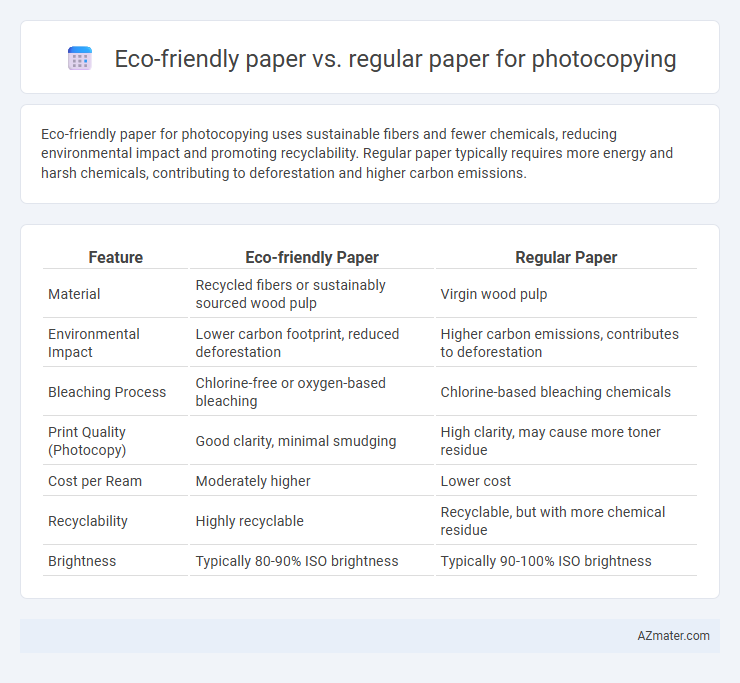Eco-friendly paper for photocopying uses sustainable fibers and fewer chemicals, reducing environmental impact and promoting recyclability. Regular paper typically requires more energy and harsh chemicals, contributing to deforestation and higher carbon emissions.
Table of Comparison
| Feature | Eco-friendly Paper | Regular Paper |
|---|---|---|
| Material | Recycled fibers or sustainably sourced wood pulp | Virgin wood pulp |
| Environmental Impact | Lower carbon footprint, reduced deforestation | Higher carbon emissions, contributes to deforestation |
| Bleaching Process | Chlorine-free or oxygen-based bleaching | Chlorine-based bleaching chemicals |
| Print Quality (Photocopy) | Good clarity, minimal smudging | High clarity, may cause more toner residue |
| Cost per Ream | Moderately higher | Lower cost |
| Recyclability | Highly recyclable | Recyclable, but with more chemical residue |
| Brightness | Typically 80-90% ISO brightness | Typically 90-100% ISO brightness |
Introduction to Photocopy Paper Types
Photocopy paper is available in various types, including eco-friendly and regular options, each designed to meet different environmental and performance needs. Eco-friendly paper is often made from recycled fibers or sustainably sourced materials, reducing environmental impact by lowering deforestation and chemical usage. Regular photocopy paper typically uses virgin pulp, offering consistent whiteness and durability but with a higher ecological footprint compared to recycled or sustainable alternatives.
Defining Eco-Friendly Paper
Eco-friendly paper for photocopying is made from recycled materials or sustainable sources, reducing environmental impact compared to regular paper which typically relies on virgin pulp from deforestation. This type of paper often uses fewer chemicals in its production process, minimizes water consumption, and decreases carbon emissions. Choosing eco-friendly paper supports responsible forestry practices and contributes to waste reduction in office environments.
What is Regular Photocopy Paper?
Regular photocopy paper is typically made from virgin wood pulp and undergoes extensive chemical processing, resulting in higher environmental impact due to deforestation and emissions. It often lacks recycled content, contributing to increased energy consumption and landfill waste. This conventional paper is designed for standard printing quality but does not prioritize sustainability or reduced carbon footprint.
Environmental Impact Comparison
Eco-friendly paper used for photocopying significantly reduces environmental impact by utilizing recycled fibers and sustainable forestry practices, thereby lowering deforestation rates and conserving biodiversity. This type of paper also requires less energy and water during production, resulting in decreased carbon emissions compared to regular paper made from virgin pulp. Choosing eco-friendly photocopy paper supports waste reduction and promotes a circular economy by enabling easier recycling and reducing landfill contributions.
Resource Consumption and Sustainability
Eco-friendly paper for photocopying significantly reduces resource consumption by utilizing recycled fibers and sustainably sourced materials, minimizing deforestation and water usage compared to regular paper. Its production processes often involve lower energy consumption and lower greenhouse gas emissions, contributing to a smaller carbon footprint. Choosing eco-friendly paper supports long-term sustainability goals by promoting circular economy principles and reducing landfill waste.
Print Quality and Performance
Eco-friendly paper designed for photocopying offers comparable print quality to regular paper, often featuring a smoother surface and consistent brightness that enhances toner adhesion and sharpness. Its performance in printers is generally reliable, reducing jams and wear on photocopy machines due to its optimized fiber composition and manufacturing process. Regular paper may vary more in texture and weight, potentially affecting image clarity and causing more frequent mechanical issues during high-volume copying tasks.
Cost Analysis: Eco-Friendly vs Regular
Eco-friendly paper for photocopying typically costs 10-30% more than regular paper due to sustainable sourcing and production processes, but it often reduces environmental impact by lowering carbon emissions and deforestation. Regular paper is generally cheaper upfront but may incur hidden costs related to environmental degradation and waste management. When evaluating long-term expenses, eco-friendly paper's durability and recycled content can offer cost savings through reduced resource consumption and improved corporate sustainability ratings.
Certifications and Standards
Eco-friendly paper for photocopying often carries certifications such as FSC (Forest Stewardship Council) and PEFC (Programme for the Endorsement of Forest Certification), ensuring responsible forest management and sustainable sourcing. These certified papers typically meet environmental standards like ISO 14001 for environmental management systems, reducing ecological impact compared to regular paper. In contrast, conventional photocopy paper frequently lacks such certifications, contributing to higher deforestation and carbon footprints without guaranteed sustainability practices.
Availability and Consumer Choices
Eco-friendly paper for photocopy is increasingly available in office supply stores and online platforms, often labeled as recycled or sustainably sourced paper. Consumer choices are influenced by environmental awareness, with more buyers opting for products certified by organizations like FSC or containing post-consumer recycled content. While regular paper remains widely stocked and typically cheaper, demand for eco-friendly alternatives continues to grow driven by corporate sustainability goals and individual preferences.
Making the Switch: Practical Recommendations
Switching to eco-friendly paper for photocopying significantly reduces environmental impact due to its use of recycled fibers and sustainable production methods, which lowers carbon footprint and deforestation risks. When making the switch, consider selecting paper certified by FSC or PEFC to ensure responsible sourcing and evaluate paper weight and brightness for compatibility with your photocopier to maintain print quality. Implementing small steps like gradually replacing regular paper, training staff on eco-friendly practices, and monitoring paper usage can optimize cost savings and environmental benefits over time.

Infographic: Eco-friendly paper vs Regular paper for Photocopy
 azmater.com
azmater.com